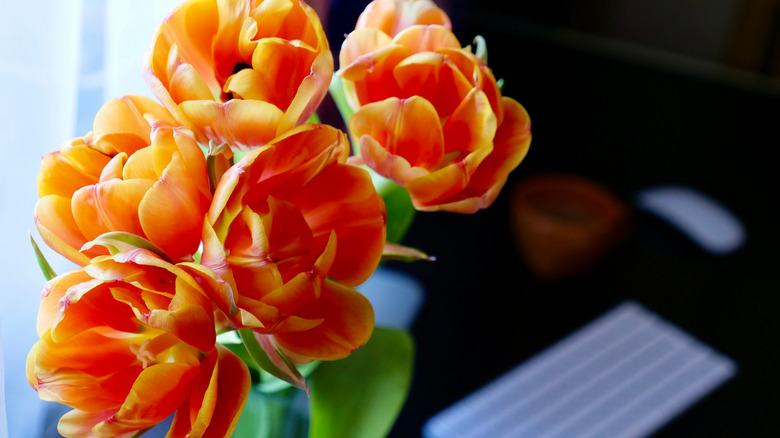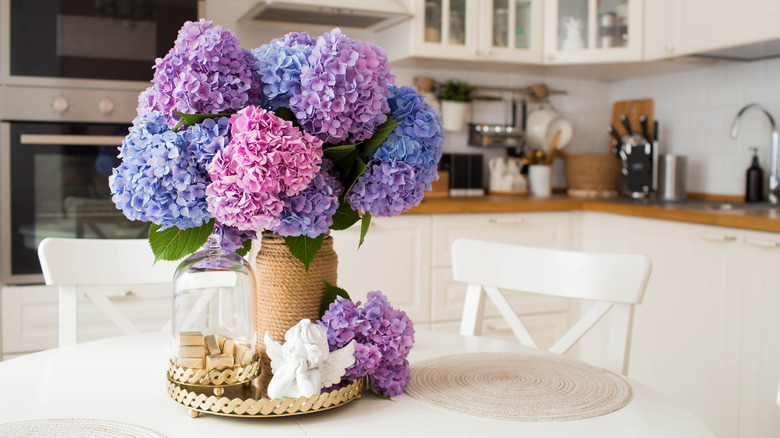Add a vase of cut flowers to any side table or kitchen counter and watch the mood of the whole room elevate. We’ve all experienced this, and love to maximize the power of the cut flower. Additionally, the tools to pull that off in our homes are more important than ever, but what if you want to nail something more precise than a general welcome-to-this-room vibe? According to recent studies, when it comes to channeling your best bliss a la the cut flower, color is what counts.
A 2024 study published in the International Journal of Environmental Research and Public Health used an EEG headset and signal to discover that certain flower colors drive home a whole other level of emotions than others. For instance, yellow flowers deliver significantly more cheeriness than their white counterparts. However, that result should not have us ditching our white lilies or excluding daisies from getting showcased in our vases. Instead, a look into the color psychology of flowers can help us more tactically pick the right blooms, depending on the needs of the day. To that end, let’s decipher the best flower shades for our home, from adding extra pep in our step as we finish a daunting project to inviting a calm cooldown to a chaotic week.
Which flower should you pick and where should you place it?

The effect of the color of flowers goes way beyond traditional symbolism, according LiLum Florals and Leatrice Eiseman, Executive Director of the Pantone Color Institute. For example, red may long be known as a symbolic nod to love — hence red roses on Valentine’s Day by the truckload — but red flowers also serve to undermine fatigue. Running low on REM sleep? Try a little vase of red tea roses or red chrysanthemums on your bathroom vanity as an added wake-me-up for your morning routine.
Yellow and orange flowers, often associated with cheeriness, also encourage communication and socialization. In that case, orange tulips splayed in a short, wide vase in your home office might be particularly nice just before your team starts that tense end-of-year budget meeting.
The psychology of that orange bouquet can also have the added benefit of making people feel that they are charming, says Patch. They further make the point that blue flowers are dual taskers that can simultaneously spark creativity while lowering blood pressure. So, got teenagers who need to finish those college essays but are dragging their feet — and are also completely stressed out at the same time? Tuck a bowl of blue hydrangeas next to their workspace.
The flower color palette for you

FTD by Design suggests that rather than singularly focusing on one color affect for cut flowers arranged in your home, you might like to leverage a color palette. Though the human eye is capable of seeing somewhere in the vicinity of a million different shades, the traditional palette is largely broken into two camps: warm or cool. Warm hues (like yellow, red, and orange) typically provoke more energy, while cool colors work to balance a more chilled-out calm against the chaos of life (often true of blues, purples, and greens).
Using a palette gives you flexibility to mix and match like shades, as well as mix and match with complementary palettes. For example, pairing blue blooms with an array of various yellows can do double duty to stimulate imagination or boost productivity while still hanging on to a chill, unruffled vibe.
That may sound like a tall order, but if anything can manage to pull that off, it seems to be flowers. Researchers at Rutgers University running studies on the power of the flower report that the sweet, fragile blooms of flowers deliver a powerful impact with unprecedented consistency — a welcome addition to the home.



